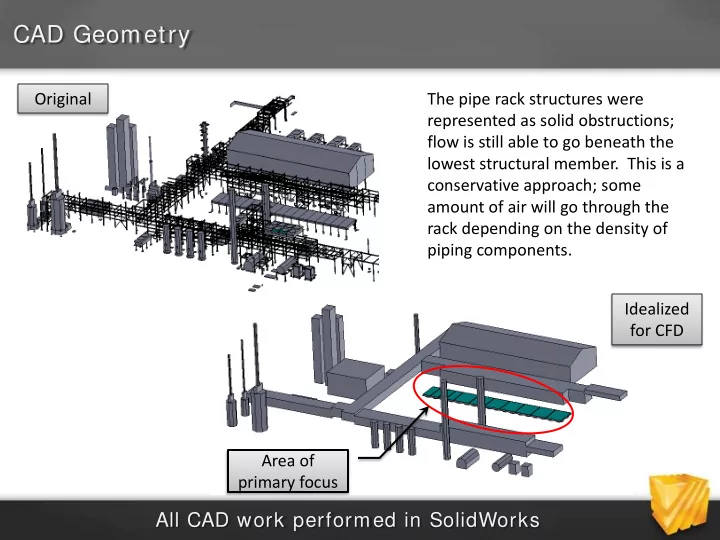

CAD Geometry Original The pipe rack structures were represented as solid obstructions; flow is still able to go beneath the lowest structural member. This is a conservative approach; some amount of air will go through the rack depending on the density of piping components. Idealized for CFD Area of primary focus All CAD work performed in SolidWorks
Simulation Flow Domain and Conditions Slip 10 mph P=0 psi Coolers are at 45° angle to flow Slip Air is at STP conditions
Cooler Unit Dimensions (typical, unit 3040 shown) Some units have a 2’ shroud Air is at STP conditions
Cooler Unit Flows and Velocities Unit ACFM/Fan # Fans V inlet (fpm) V outlet (fpm) 3037 80,874 2 1030 480 3038 126,473 2 1610 772 3039 115,919 2 1476 725 3040 124,629 2 1587 746 3021 110,863 4 1412 657 3020 110,833 4 1411 703 3019 62,233 4 792 357 3307 130,689 4 1664 732 3306 140,054 4 1783 737 3916 126,628 4 1612 743 3917 129,685 4 1651 715 Inlet velocities are calculated at the fan inlet.
Simulation Assumptions • Incompressible, homogenous air used as the fluid medium. • Air is at standard temperature and pressure (STP) with constant density and viscosity. • Adiabatic conditions; heat transfer not considered. • Steady-state flow results; no transient effects. • Constant velocity conditions across the cooler inlets and outlets. • Ambient wind speed of 10 mph from SW. – Typical speed for site confirmed from the National Climatic Data Center www.ncdc.noaa.gov/ oa/ ncdc.html
Overall Particle Traces Note recirculation Traces are seeded from cooler outlets.
Why are some units showing slight recirculation? • Strong suction at the inlet is in close proximity to the Strong suction leading edge of the outlet. • A short circuit path exists between the inlets and outlets between the catwalk. • The ambient horizontal air is colliding with the strong vertical air column from the Flow collision fan exhaust. • The combination of these factors provides the opportunity for a small percentage of recirculation to occur.
Unit Recirculation Details: 1 of 3 3037 3038 No recirc No recirc 3039 3040 Note short-circuit path between cooler and Recirc catwalk. Traces are seeded from the fan inlets.
Unit Recirculation Details: 2 of 3 3021 3020 3019 3307 Traces are seeded from the fan inlets.
Unit Recirculation Details: 3 of 3 3916 3306 3917 Note that since the units are at a 45 degree angle to the ambient flow, the recirculation into a unit mostly comes from the units upstream Traces are seeded from the fan inlets.
Cooler Unit Recirculation Estimates Unit % • Estimates made by seeding Recirculation 100 traces from each fan inlet and then counting number of 3037 0 traces with come from the fan 3038 0 outlets. 3039 1 3040 5 3021 5 3020 2.5 3019 2.5 3307 2.5 3306 7 3916 8 3917 3.5
Summary • Some amount of recirculation observed at leading edge of units due to interaction between ambient and exhaust air streams. • A short-circuit path exists between the cooler and the catwalk; eliminating or extending this path could prevent any recirculation • Possible solutions: – Adding a kick plate from the catwalk to the cooler to eliminate the short-circuit path. – Adding a skirt above the cooler unit which extends to short-circuit path Results may vary for other wind speeds and directions.
Appendix – Validation Overview • Used to prove that this application is dominated by forced convection and that buoyancy (air density change due to temperature variation) has little to no impact on results. • Test isolated to unit 3040 • Temperatures: – Ambient: 110 °F – Discharge: 128.2 °F • External air flow: 10mph • An 18°F rise in air temperature only results in a 3% reduction in air density. Results reveal minimal difference between constant and buoyant air.
Appendix – Validation Particle Traces Constant Buoyant Note hot air recirculation
Appendix – Validation Flow Vectors Constant Buoyant
Appendix – Validation Temperature Profile Constant Buoyant Note hot air Some impact on recirculation downstream temps
Recommend
More recommend